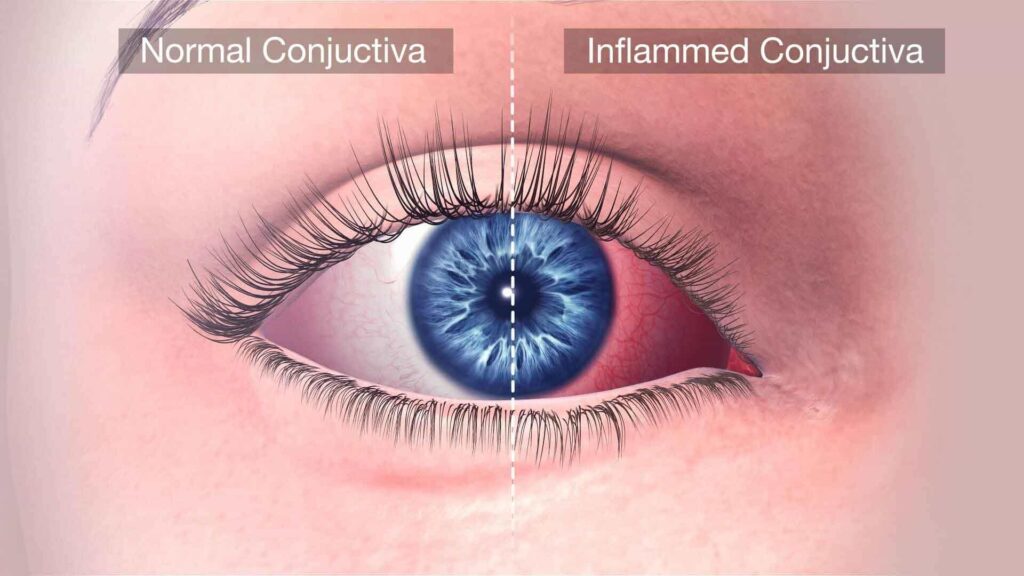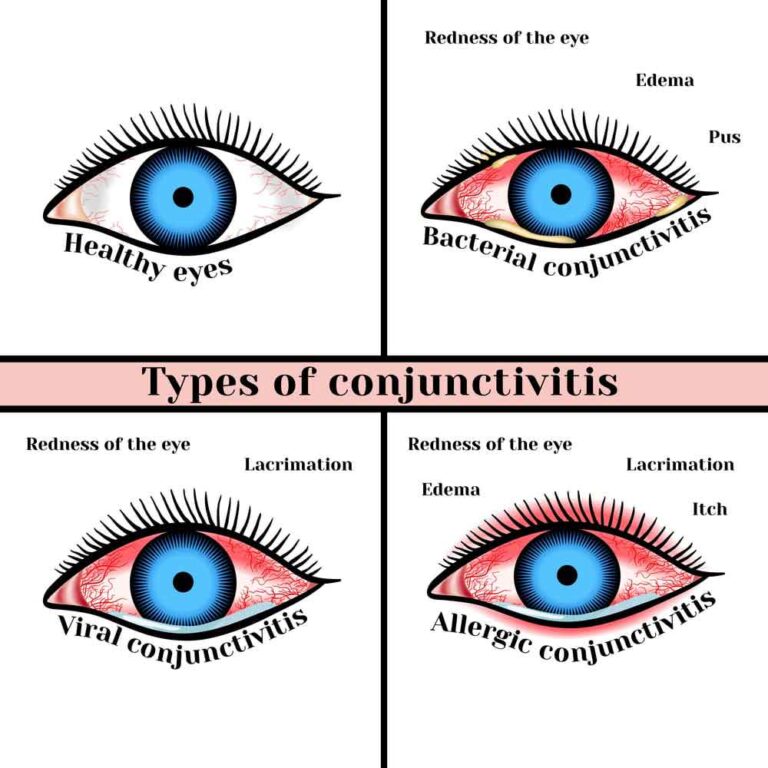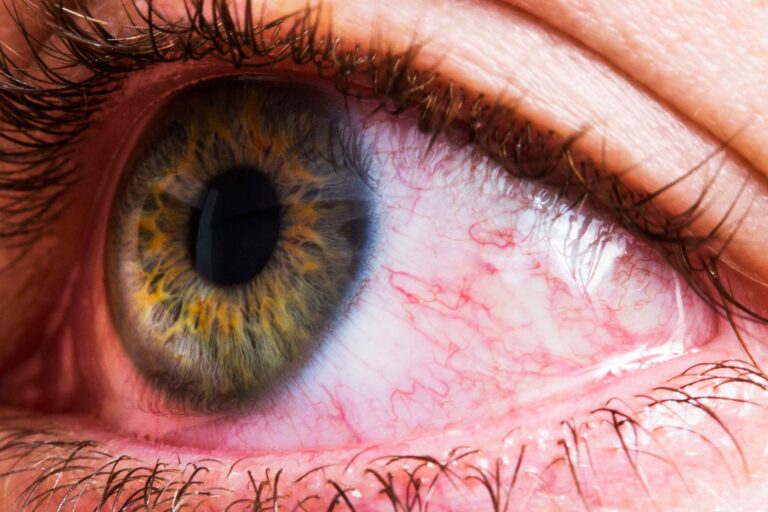WHAT IS PINK EYE (CONJUNCTIVITIS)?
Pink eye (conjunctivitis) is an inflammation or infection of the transparent membrane (conjunctiva) that lines your eyelid and covers the white portion of your eyeball. When tiny blood vessels in the conjunctiva become inflamed, they are more visible. This is what causes the whites of your eyes to seem reddish or pink.
Pink eye is frequently caused by a bacterial or viral infection, an allergic reaction, or — in babies — an incompletely opened tear duct.
Though pink eye could be irritating, it rarely affects your vision. Treatments could help ease the discomfort of pink eye. Because pink eye could be contagious, early diagnosis and treatment can help limit its spread.
PINK EYE SYMPTOMS
- The most common pink eye symptoms are :
- Redness in one or both eyes
- Itchiness in one or both eyes
- Gritty feeling in one or both eyes
- A discharge in one or both eyes that forms a crust during the night that might prevent your eye or eyes from opening in the morning
- Tearing
WHEN SHOULD YOU SEE A DOCTOR?
There are severe eye conditions that can cause eye redness. These conditions might cause eye pain, a feeling that something is stuck in your eye (foreign body sensation), blurred vision, and light sensitivity. If you experience these symptoms, ask for urgent care.
People who wear contact lenses need to stop wearing their contacts as soon as pink eye symptoms start. If your symptoms do not start to get better within 12 to 24 hours, make an appointment with your eye doctor to ensure you do not have a more severe eye infection related to contact lens use.
PINK EYE CAUSES
Causes of pink eye include :
- Viruses
- Bacteria
- Allergies
- A chemical splash in the eye
- A foreign object in the eye
- In newborns, a blocked tear duct
Viral and Bacterial Conjunctivitis
Most cases of pink eye are typically caused by adenovirus but could also be caused by herpes simplex virus, varicella-zoster virus, and various other viruses, including the virus that causes coronavirus disease 2019 (COVID-19).
Both viral and bacterial conjunctivitis can occur along with colds or symptoms of a respiratory infection, like a sore throat. Wearing contact lenses that are not cleaned properly or are not your own can cause bacterial conjunctivitis.
Both types are extremely contagious. They are spread through direct or indirect contact with the liquid that drains from the eye of someone who is infected. One or both eyes might be affected.
Allergic conjunctivitis
Allergic conjunctivitis affects both eyes and is a response to an allergy-causing substance like pollen. In response to allergens, your body produces an antibody referred to as immunoglobulin E (IgE). This antibody triggers special cells known as mast cells in the mucous lining of your eyes and airways to release inflammatory substances, including histamines. Your body’s release of histamine could produce a number of allergy signs and symptoms, including red or pink eyes.
If you have allergic conjunctivitis, you might experience intense itching, tearing and inflammation of the eyes — as well as sneezing and watery nasal discharge. Most allergic conjunctivitis could be controlled with allergy eyedrops.
Conjunctivitis resulting from irritation
Irritation from a chemical splash or foreign object in your eye is also related to conjunctivitis. At times flushing and cleaning the eye to rid it of the chemical or object causes redness and irritation. Signs and symptoms, which might include watery eyes and a mucous discharge, usually clear up on their own within about a day.
If initial flushing does not resolve the symptoms, or if the chemical is a caustic one like lye, you need to be seen by your doctor or eye specialist as soon as possible. A chemical splash into the eye could cause permanent eye damage. Persistent symptoms can also indicate that you still have a foreign body in your eye — or possibly a scratch over the cornea or the covering of the eyeball (sclera).
PINK EYE RISK FACTORS
Risk factors for pink eye include :
- Exposure to something to which you are allergic (allergic conjunctivitis)
- Exposure to an infected person with the viral or bacterial form of conjunctivitis
- Using contact lenses, particularly extended-wear lenses
PINK EYE COMPLICATIONS
Preventing the spread of pink eye
Practice proper hygiene to control the spread of pink eye. For instance :
- Never touch your eyes with your hands.
- Wash your hands often.
- Use a clean towel and washcloth regularly.
- Do not share towels or washcloths.
- Change your pillowcases often.
- Throw away your eye cosmetics, like mascara.
Never share eye cosmetics or personal eye care items.
Keep in mind that pink eye is not more contagious than the common cold. It is okay to return to work, school, or child care if you are not able to take time off — just stay consistent in practicing good hygiene.
Preventing pink eye in newborns
Newborns’ eyes are vulnerable to bacteria normally present in the mother’s birth canal. None of these bacteria cause any symptoms in the mother. In rare cases, these bacteria can cause infants to develop a severe form of conjunctivitis known as ophthalmia neonatorum, which needs treatment without delay to preserve sight. This is why shortly after birth; an antibiotic ointment is applied to all the newborn’s eyes. The ointment helps avoid eye infections.
PINK EYE DIAGNOSIS
In most cases, your doctor could diagnose pink eye by asking questions about your symptoms and recent health history. A visit to the office is generally not necessary.
Rarely, your doctor might take a sample of the liquid that drains from your eye for lab analysis (culture). A culture may be needed if your symptoms are severe or if your doctor suspects a high-risk cause, like a foreign body in your eye, a severe bacterial infection, or a sexually transmitted infection.
PINK EYE TREATMENT
Pink eye treatment is generally focused on symptom relief. Your doctor might recommend using artificial tears, cleaning your eyelids with a wet cloth, and applying cold or warm compresses several times daily.
If you wear contact lenses, you will be advised to stop wearing them till treatment is complete. Your doctor will likely recommend that you throw out contacts you have worn if your lenses are disposable.
Disinfect hard lenses overnight before using them again. Ask your doctor if you should discard and replace your contact lens accessories, like the lens case used before or during the illness. Also, replace any eye makeup used prior to your illness.
In most cases, you would not need antibiotic eyedrops. Since conjunctivitis is generally viral, antibiotics would not help, and may even cause harm by reducing their effectiveness in the future or causing a medication reaction. Instead, the virus requires time to run its course — up to two or three weeks.
Viral conjunctivitis often starts in one eye and then infects the other eye within a few days. Your signs and symptoms should slowly clear on their own.
Antiviral medications might be an option if your doctor determines that your viral conjunctivitis is caused by the herpes simplex virus.
Treatment for allergic conjunctivitis
If the irritation is allergic conjunctivitis, your doctor might prescribe one of many different types of eyedrops for people with allergies. These might include medications that help control allergic reactions, like antihistamines and mast cell stabilizers, or drugs that help control inflammation, like decongestants, steroids, and anti-inflammatory drops.
Over-the-counter eyedrops that contain antihistamines and anti-inflammatory medications also might be effective. Ask your doctor if you are not sure which product to use.
You might also reduce the severity of your allergic conjunctivitis symptoms by avoiding whatever causes your allergies when possible.
If you or anyone you know is suffering from pink eye (conjunctivitis), our expert providers at Specialty Care Clinics will take care of your health and help you recover.
Call 469-545-9983 to book a telehealth appointment for an at-home check-up.




